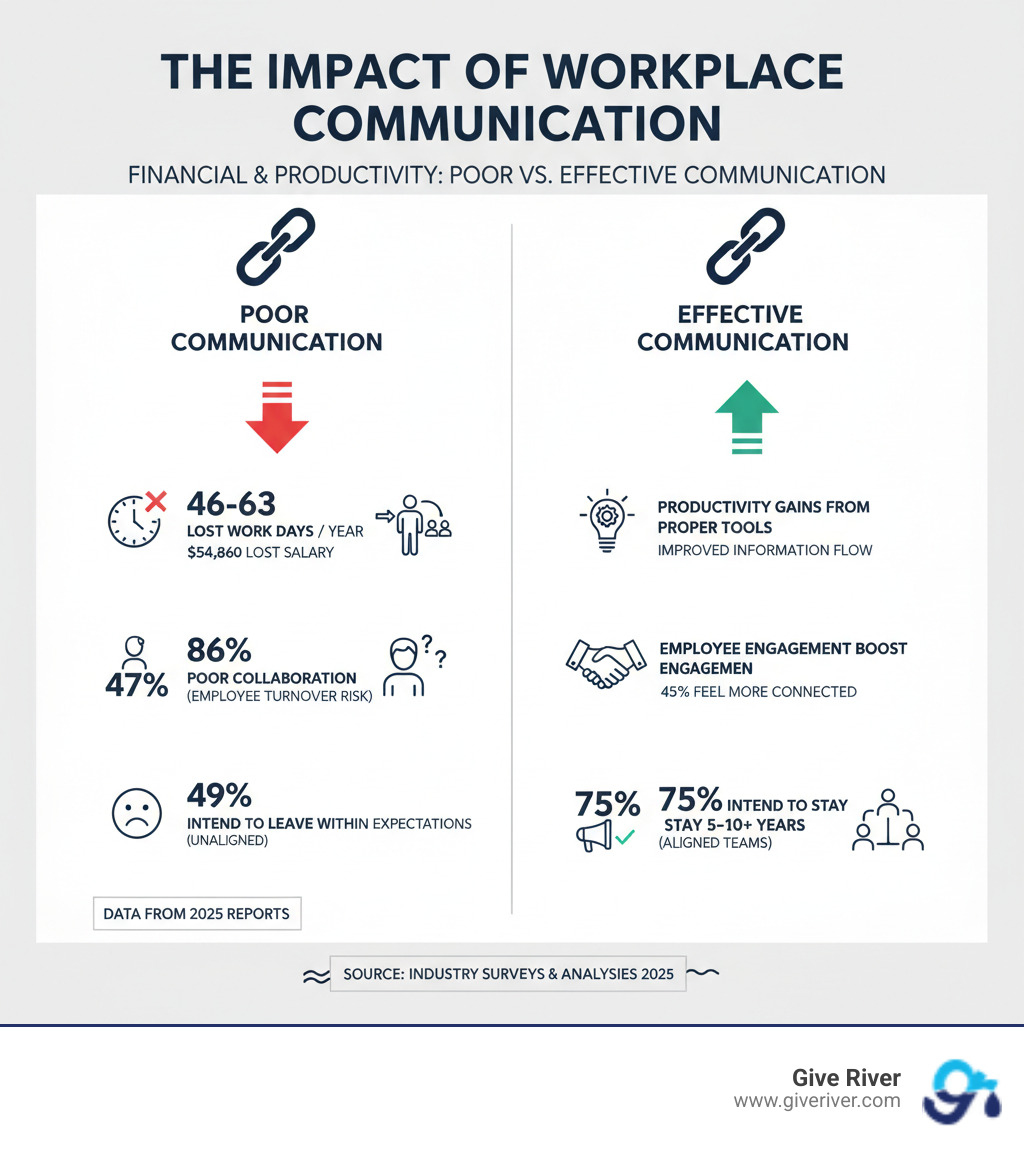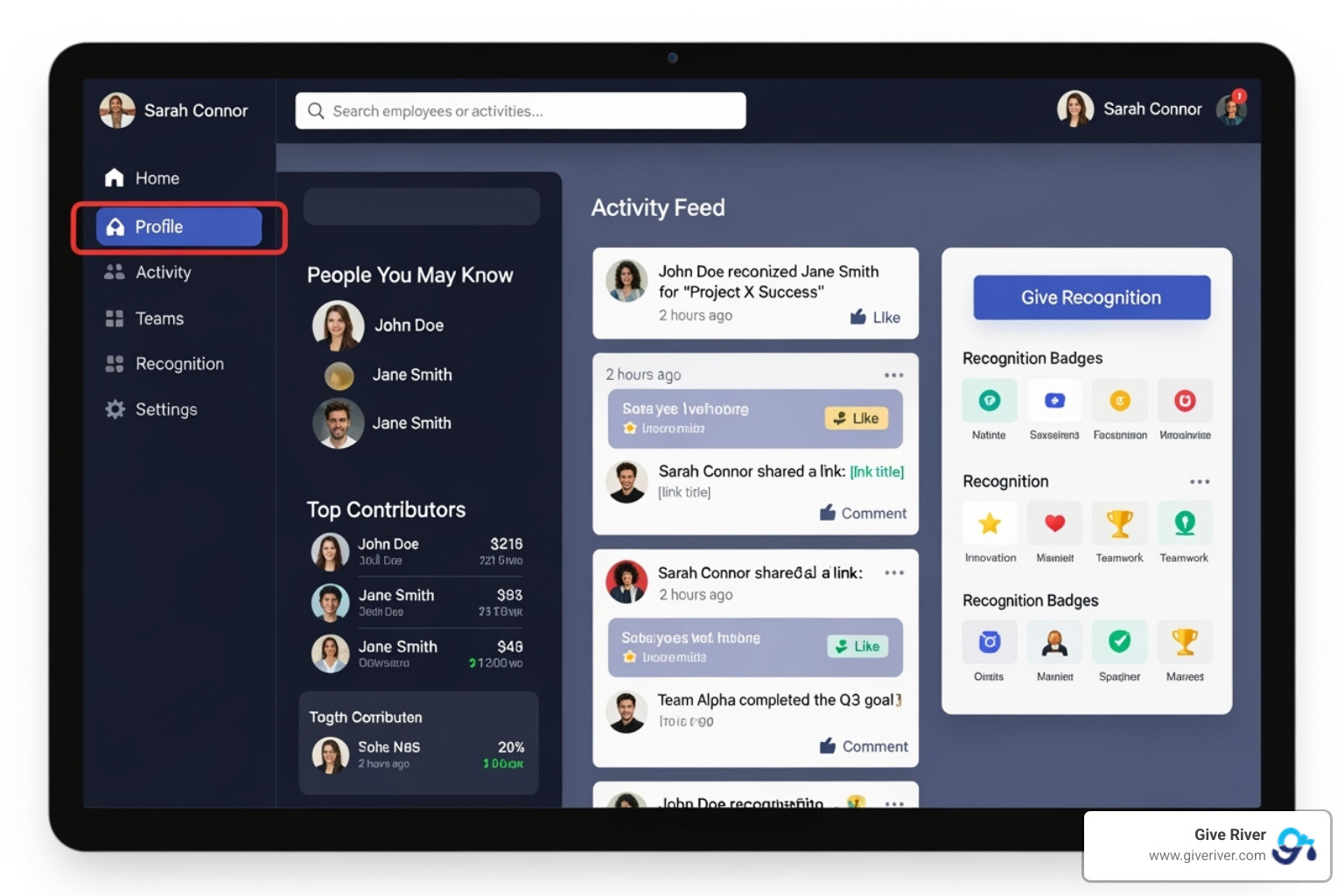The Ultimate List of Digital Collaboration Tools for Your Workplace
Transform your team's culture! Explore top workplace communication tools for collaboration, recognition, and lasting success.

Why the Right Communication Tools Matter for Your Team
Workplace communication tools are the backbone of modern business, yet many organizations struggle to get them right. The cost of ineffective communication is staggering, with companies losing thousands of dollars per employee annually, while 86% of employees blame it for a lack of collaboration.
Essential workplace communication tools include:
- All-in-One Collaboration Hubs - Microsoft Teams, Slack, or comprehensive platforms like Give River that combine communication with employee engagement
- Project Management Platforms - Asana, Trello, or integrated solutions that align team goals with daily communication
- Video Conferencing Tools - Zoom, Google Meet, or platforms with built-in recognition features
- Internal Communication Systems - Staffbase, Workshop, or tools that foster culture and connection
- Employee Engagement Platforms - Give River, Bonusly, or Kudos for recognition-driven communication
The challenge is greater in remote and hybrid environments. While digital tools can increase connection, 47% of workers are overwhelmed by too many apps, creating information silos that hurt productivity and satisfaction.
Here's what's at stake: A major disconnect exists between leaders and employees on communication clarity. This isn't just about messaging—it's about building a culture where people feel fulfilled, recognized, and connected to their team's mission.
Successful organizations know that communication tools aren't just for efficiency—they create an environment where employees thrive. Companies with well-connected teams see 75% of their employees planning to stay for 5-10+ years, compared to 49% of unaligned employees who plan to leave within two years.
I'm Meghan Calhoun, and after two decades in high-pressure communication roles, I've learned that the right workplace communication tools transform both productivity and fulfillment. Through my work co-founding Give River, I've seen how combining effective communication with recognition and team-building creates cultures where people want to contribute their best work.

The Best Digital Collaboration Tools for Building a Connected Workplace in 2025
The landscape of workplace communication tools has evolved dramatically. Today's most effective tools don't just help us communicate—they help us connect, recognize contributions, and build a culture where people want to do their best work.
Let's explore the three categories of platforms shaping the future of connected workplaces.
All-in-One Collaboration Hubs: Centralizing Team Communication
These platforms act as a digital headquarters, bringing conversations, files, and updates together to eliminate app-switching and endless email searches.
Microsoft Teams is a go-to for organizations in the Microsoft 365 ecosystem, weaving together chat, video calls, file sharing, and app integrations into one cohesive experience. It connects people across departments for faster decision-making.
Slack is known for its intuitive interface and over 2,600 app integrations. Its channel-based approach organizes conversations, while AI features can save users significant time by automating routine tasks, creating a true productivity platform.
Give River takes a unique approach by combining communication with the human elements of work. Our platform weaves recognition, wellness, and growth opportunities into daily interactions, so teams aren't just coordinating tasks—they're celebrating wins and staying connected to company values.
When teams can easily share updates and recognize great work in one place, you create an environment where transparency and trust flourish.

Project & Task Management: Organizing for Success
Effective workplace communication tools connect conversations to meaningful progress. Project management platforms ensure coordination efforts move the needle on what matters.
Asana excels at helping teams plan projects, assign responsibilities, and track progress with visual workflows and Kanban boards. These are game-changers for distributed teams, supporting asynchronous communication without constant meetings.
These tools are essential for reducing email clutter. With many employees ignoring work emails, project management platforms create focused spaces where important updates get seen and acted upon in context.
The real power comes from aligning teams around shared goals. When daily tasks connect to bigger objectives, every team member understands their contribution. This alignment is critical, as companies with aligned teams retain employees far longer.
Give River's approach integrates goal tracking with recognition, ensuring that as projects move forward, teams stay motivated. Celebrating milestones alongside tasks strengthens relationships and builds momentum.
Tools for Engagement, Recognition, and Connection
This is where modern workplace communication tools truly shine. Platforms focused on engagement and human connection transform good teams into great ones. They address the need for connection, as strong workplace friendships are linked to higher job satisfaction.
Give River's unique game of good deeds makes recognition a fun, natural part of the workday. Our platform turns gratitude into an everyday practice, building a culture where people feel valued for contributions big and small.
Competitors like Bonusly and Kudos also focus on peer-to-peer recognition, but our comprehensive approach builds a culture of generosity that extends beyond the workplace, creating deeper connections.
Video conferencing integration becomes more powerful when connected to team building. Teams can use video calls not just for work updates, but for celebrations and personal check-ins that strengthen relationships.
Branded internal communication tools ensure company values reach everyone in an engaging way, building the transparency and trust that makes all other communication more effective. Engagement tools are fundamental—when people feel connected and valued, they collaborate more willingly and contribute more creatively.
How to Choose and Implement the Right Digital Collaboration Tools
Finding the perfect workplace communication tools is like choosing a home for your team to build something meaningful. The right platform becomes the foundation for collaboration and growth, defining the digital space where relationships form and culture lives.
Key Features to Evaluate in Workplace Communication Platforms
When evaluating platforms, ask: "What would make our team's day easier and more fulfilling?" Focus on these key features:
- Security and compliance: This is a non-negotiable foundation. Your tools need end-to-end encryption, multi-factor authentication, and compliance with regulations like GDPR to protect data and build trust.
- Scalability: Choose a platform that can grow with your organization. A tool for a five-person startup may not support a fifty-person company, forcing a disruptive migration later.
- User experience (UX): An intuitive, clean interface is crucial for adoption. If a platform is clunky, your team will revert to old habits like email, defeating the purpose of the investment.
- Mobile access: With remote and deskless workers, a seamless mobile experience is essential. A poor mobile app creates a frustrating, two-tiered communication system.
- Analytics and reporting: Use data to understand how your team communicates. Actionable insights on message readership and collaboration patterns help you improve workflows.
- AI-powered insights: Modern AI can summarize conversations, suggest content, and automate tasks. For example, some tools use AI to provide daily recaps, saving users valuable time each week.
- Integration with your existing tech stack: To prevent app fatigue, ensure your communication platform integrates with your CRM, project management tools, and other essential software for a seamless workflow.

A Strategic Approach to Selecting Your Platform
Successful implementations follow a thoughtful, inclusive process. Start by assessing your team size and business needs. Identify your current communication pain points and what would make your team feel more connected.
Budget considerations should include the total cost of ownership, including training and support. A slightly more expensive platform that your team loves often delivers a better ROI.
Involving employees in the decision is smart business. Gather their insights on frustrations and desired features through surveys or focus groups to ensure buy-in.
Running pilot programs with a small group can reveal unexpected issues and create internal champions who can help with the full rollout.
Ensuring future-proof solutions means choosing vendors with strong development roadmaps who adapt to new workplace trends.
Most importantly, choose tools that foster connection and fulfillment. The best workplace communication tools build culture. While platforms like Bonusly and Kudos focus on recognition, Give River's comprehensive 5G Method integrates recognition, guidance, wellness, gamification, and community impact to create genuine employee fulfillment.
By taking a strategic approach, you're not just buying software—you're investing in the daily experience of every person on your team. The goal is to find the right platform for your unique culture and goals, turning communication into connection.
Conclusion: Building a Thriving Culture with the Right Tools
Choosing the right workplace communication tools is about changing how your team connects and thrives. Effective platforms are the building blocks of a culture where people want to contribute their best work.
The path forward requires a thoughtful integration of tools. While collaboration hubs and project management platforms drive progress, thriving organizations go further. They choose platforms that weave recognition, connection, and appreciation into daily workflows.
This human element is crucial. While competitors like Bonusly and Kudos focus on recognition, lasting change happens when tools support the whole person. When workplace communication tools foster gratitude and celebrate achievements, work becomes a community where employees belong.
Organizations with well-connected teams see 75% of employees planning to stay for 5-10+ years, compared to just 49% in disconnected environments. This is the result of creating spaces where people feel heard, valued, and connected to a shared mission.
At Give River, our 5G Method embodies this holistic approach. By integrating recognition, guidance, wellness, gamification, and community impact, we help build cultures of purpose and belonging.
The investment in the right tools pays dividends beyond productivity. Purposeful, recognition-infused communication builds an environment where people are inspired to achieve great things together. By taking a strategic approach, you can break down silos, boost collaboration, and create a culture that attracts and retains top talent.
Ready to lift your team's connection and performance? Find how Give River can transform your workplace into a hub of fulfillment and productivity. More info about team-building solutions.






